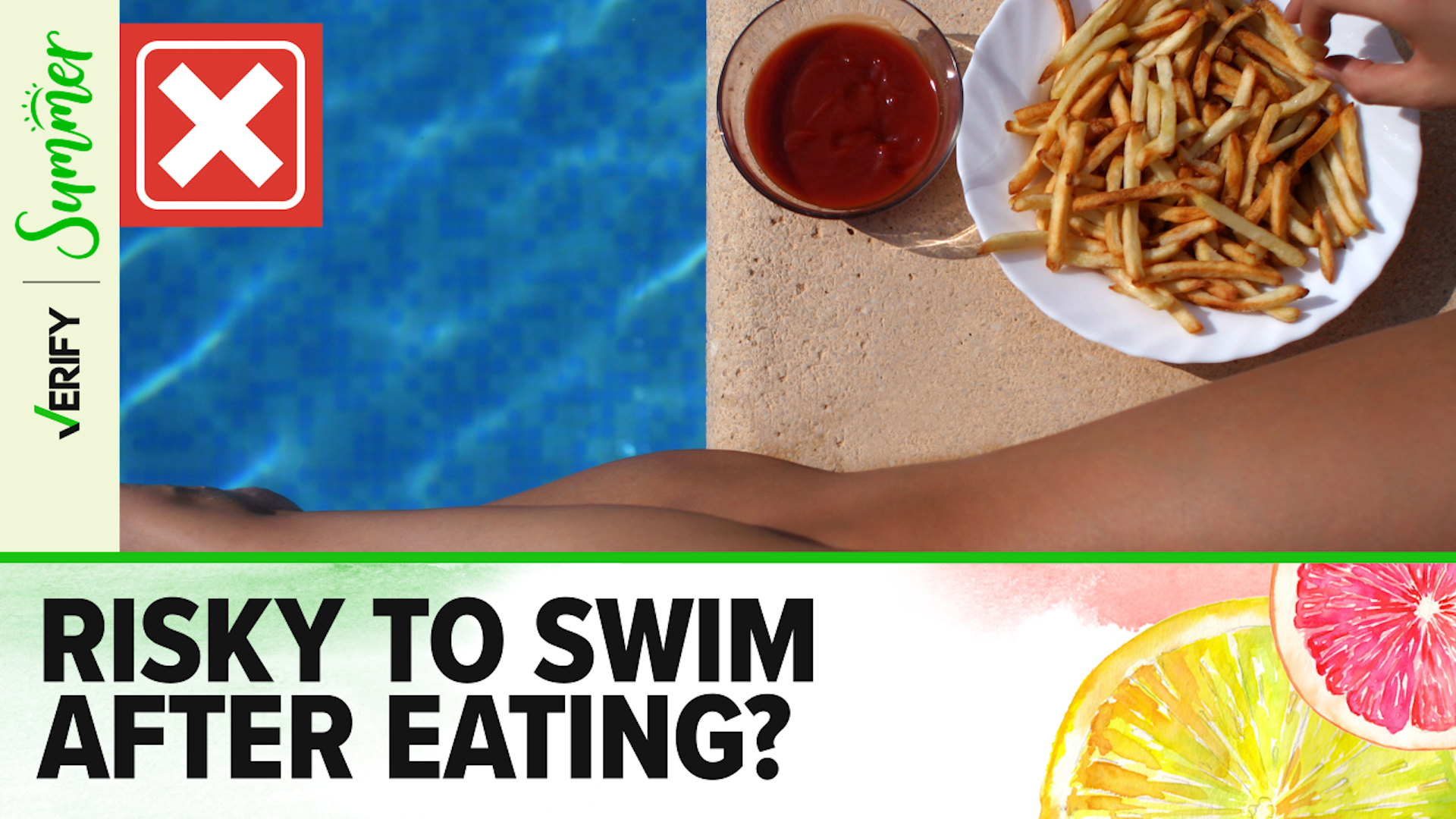VERIFY asked our readers about some of the food folktales they’ve heard over the years, and which ones they’d like to see fact-checked.
A common question we got was about a warning almost all of us have heard: You should wait at least 30 minutes after eating before swimming.
According to this advice, it’s dangerous to swim immediately after eating because your body will need to direct blood to both your digestive system and your muscles at the same time. So you run the risk of drowning either because you’ll allegedly get severe cramps, or because your limbs won’t get enough blood flow to keep you afloat.
THE QUESTION
Is it dangerous to swim within 30 minutes of eating?
THE SOURCES
- American Red Cross
- The Mayo Clinic
- Dignity Health, a California hospital provider
- University of Arkansas for Medical Services
- Boy Scout handbooks from 1908 and 1911, and a Girl Scout handbook from 1918
- Bwalya Lungu, Ph.D., a food science and food folklore professor at the University of California Davis
THE ANSWER
No, it’s not dangerous to swim within 30 minutes of eating.
WHAT WE FOUND
In 2011, the American Red Cross reviewed 50 years of scientific literature about eating and swimming, and concluded that “eating before swimming is not a contributing risk for drowning and can be dismissed as a myth.”
The American Red Cross added that it found no reported cases of someone drowning or almost drowning because they ate right before getting in the water. It also didn’t find any major medical or safety organizations that recommend waiting to swim after eating.
While your body does need to distribute blood to your stomach for digestion and to your limbs for physical activities like swimming, there is plenty of blood to go around.
“These concerns are unwarranted because your blood just isn't diverted enough to cause any real problems,” Dignity Health, a California hospital provider, said. “There are no documented deaths attributed to anyone swimming on a full stomach.”
Bwalya Lungu, Ph.D., a food science and food folklore professor at the University of California Davis, explained that the body and brain know how to balance its processes to send whatever you need wherever you need it, including blood for both digestion and muscle activity.
“The body understands it needs to digest the food, right? And so if [the myth was true], then every time you are eating it would mean you can't do any other activity at all because all the blood is being diverted to the stomach,” Lungu said. “So you can't be walking and eating. You can't be running. You just can't do anything. And yet, we can do a number of other activities as we're eating — because not all the blood is diverted.”
If you do get a muscle cramp, while you’re swimming or doing anything else, it’s likely caused by dehydration, overuse of a muscle, muscle strain or simply holding a position for a prolonged period, not because of blood going multiple places at once, according to the Mayo Clinic. There are medical conditions that may cause cramps based on inadequate blood supply to your legs and feet, but people who get these kinds of cramps get them because the arteries delivering blood to their legs are too narrow, not because their body isn’t pumping enough blood in that direction.
The University of Arkansas for Medical Services says you may get “some cramping” — not severe, debilitating cramps — if you do strenuous exercise in the pool immediately after eating, but it says that’s true of eating before any strenuous exercise, and that swimming recreationally immediately after eating shouldn’t pose any problems.
Origins of the myth
So if there’s no evidence of risk from swimming immediately after eating, how did this myth begin?
Both Dignity Health and Lungu point to a 1908 Boy Scout handbook as the first recorded instance of this myth.
“Never bathe in deep water very soon after a meal, it is very likely to cause cramp, which doubles you up, and so you get drowned,” the original British version of the 1908 Scouting for Boys handbook said.
That warning then made its way to the first Boy Scouts of America handbook in 1911, which said, “Many boy swimmers make the mistake of going into the water too soon after eating. The stomach and digestive organs are busy preparing the food for the blood and body. Suddenly they are called upon to care for the work of the swimmer. The change is too quick for the organs, the process of digestion stops, congestion is apt to follow, and then paralyzing cramps.”
By the time the first Scouting for Girls handbook was published in 1918, the myth had become more specific, “If you bathe within an hour and a half of taking a meal, that is before your food is digested, you are very likely to get cramp. Cramp doubles you up in extreme pain so that you cannot move your arms or legs, and down you go and drown.”
Reprints of the original handbook, including one published in 1954 and another published in 1963, also warn that you should wait an hour and a half after a meal before taking a dip — adding that “it will be your own fault” if you drown. This is the version cited as the original a number of articles, beginning with a 2001 Snopes article, but it wasn’t what Boy Scouts would have read in 1908.
“Where the Boy Scout handbook got the idea isn't known, but it certainly wasn't accurate,” Dignity Health says.

